









The Estate through the agesPrehistoryDuring the Stone Age the entire region of Sodermanland was submerged under the Baltic Sea; the many lakes are fjords and gulfs that the rising of the land have left behind. Around the lake Baven are plenty of prehistoric sites, for these lands were easily defended and the people had trade routes on the waterways out to the Baltic Sea. At the northern end of the lake was a small, flat hill on three sides surrounded by water. This spot is where Rockelstad lies today. It is a natural place for a settlement that probably was inhabited as early as the Iron Age, of which testify the remains of two hill-top fortresses, built in the first centuries AD. The very spot where the castle and its wings are today was most likely inhabited from the Viking Age on. The name Rockelstad was pronounced "Rok-li-stad" by the Viking tongue. Rokli is Old Nordic for "little rock", which is quite apparent in English. Rockelstad thereby means, not very poetically, the place on the little rock.The middle AgesRockelstad appears in written history the first time in the 14th century, when the Bishop of Strangnas bought Roklista village and estate by the priest in Forssa. The church's possession of the land meant that new and prestigious buildings were built. These houses with vaulted cellars of bricks were built around 1380. The estate has more or less the same perimeter today as in medieval times. The ownership of the Rockelstad Estate was transferred to the Crown at the land-reduction of King Gustav Vasa in the 1520ies, when he abolished the Catholic Church. The land was distributed to his son, Duke Charles of Sodermanland, who in his turn passed it on to an officer in his service, his Master of Quarter, a Sean Stuart. He belonged to a branch of the Scottish royal family, and he went to Sweden as a mercenary serving the sons of Gustav Vasa during their wars with Denmark.The Stuart AgeSean Stuart left Rockelstad to his son David, who decided to make the estate his Seat. At that time a nobleman had the right to name one of his estates the Seat of his family. Such a land did not have to pay tax, but to receive authorisation as a noble Seat it was needed to arrange facilities and maintenance according to specific demands by the state. Therefore David had the medieval buildings demolished and erected a larger wooden mansion, partly on the old foundations. This was in AD 1642. Beneath it's typically shaped slated roof it now had a second floor, but the 14th century cellars were kept, and are still in use today. It was one of the privileges of a noble Seat to be freed of the usual window-tax, so David Stuart could afford as many as 28 windows on his house. David was married twice, first with Anna Kruse of Elghammar and later with Brita Liljeram of Langbro. These two ladies are the famous Ladies Stuart, the traditional Ghosts of Rockelstad, who still haunts the west wing.John Robert Stuart took over the estate in 1660. He was also married twice, first with Anna Oliokvist, then with Beata Gyllenanckar. The later wife came from a wealthy family and brought a substantial dowry with her. The large west wing was aimed from the start to be the guest-house. The east wing was the kitchen-wing, from where the food was carried into the mansion, but which also had rooms for washing and storing textiles, bedrooms for the maids and a schoolroom. The two small wings were built to be the dairy and the carpentry of the estate. On a map, depicting the estate as it were in the 17th century, a sawmill can be seen; it was operational in the early part of the century. It probably provided timber from the woods of the estate, when all of these houses were being built. The 18th and 19th CenturiesAfter a period of frequent owner-changes, the estate was bought by Carl Sylvan in 1887. Sylvan was a successful merchant who could pride himself with the title of Commissioner for the Royal Court. He had the ambition, in line with current fashion, to transform the old mansion to a romantic miniature 16th century castle. For this purpose the he had four sturdy domed corner-towers erected in 1889, round ones toward the yard and square toward the lake. The Turkish room in the south-western tower is preserved in its original appearance, and it illuminates the fascination for the Orient that was a part of the spirit of that time. Also the dining-room in the lower floor of the castle is unchanged after the Sylvan reconstruction, with high panels and a large vault leading into the adjoining music-chamber in the tower. When they tore a hole in the old wooden mansion, they rediscovered the decorated ceilings from the Stuart-era, which had been covered with cloth since the 18th century. The fantastic ceiling in the dining-room with its acanthus ornaments and illustrated Latin proverbs was renovated by Sylvan, for in the late 19th century such overflowing interiors had again become popular. The surrounding estate was put in order as well; a new stable was erected, adorned with wooden lacework, and the Park was supplied with a bowling-alley, which still is in playable condition. The Park at that time continued far out onto the peninsula on the east side of the lake, and here he placed a little romantic cabin in Wilhelm-Tell style, that the current owners have restored. Carl Sylvan did not have time to enjoy his Sleeping-Beauty castle, however, for construction costs and a recession made him go bankrupt, and he had to escape to America, where he eventually ended up as the owner of several hotels in Chicago. The von Rosen eraSedan When Rockelstad was due prepared Eric could marry his betrothed, Mary Fock. But in spite of all this he longed to go on Viking journeys to faraway lands. He had participated in one expedition already, to Argentine and the Bolivian Andes, in 1901-1902. In advance of this journey he had gone through an education in ethnography, and it was as an ethnographer he wanted to make his mark. He decided in 1911 to cross the African continent from south to north, a journey from Cape to Alexandria, with the hope of finding undiscovered tribes and artefacts. Most of the way he went by foot, the trip took nearly two years and he came back loaded with objects. One previously unknown tribe was discovered, the Batwa-people in the marshlands of Tanganyika deep in the Congo's. The great hall at Rockelstad was arranged as an ethnographical museum, where African trophies and shrunken pygmy heads as well as South American Indian objects, were displayed. In adjacent rooms were collections of items of Swedish and European cultural-history, from the Stone-age and forward. On the shelves of the Book-room was kept a gathering of medieval illustrated manuscripts and other rare books. This home that was in fact a museum became a popular site for knowledge-seekers, and was according to the von Rosen family visited by 100.000 people between the world wars. Eric also published accounts of his adventures in books and articles. The countess Mary von Rosen was a colourful personality like her husband. She had inherited a profound religious sentiment from her Irish mother, and she had in 1909 a chapel built in one of the towers. This room, designed by Tengbom, is in a sincere medieval fashion. On the walls, borne by polygonal pillars, are the nine revelations of Saint Bridget painted, why the room is called the Chapel of St. Bridget. Mary was also the originator of Societas Sanctae Birgittae, a protestant counterpart to the Catholic Order of St. Bridget. Count von Rosen's devotion to hunting is apparent not only through the Great Russian bear in the hall, which has become something of a symbol for Rockelstad. In a large area of natural forest that Eric made into a protected reserve, is a remarkable hunting-lodge. It was built in 1910-1911 by a team of timber-men from Dalarna, following drawings by Tengbom. The lodge is in Old Nordic style, with the heads of the Fenris-wolf on the roof and a high-seat flanked by Odin and Thor, each carved from a massive piece of timber. The west wing went through a thorough renovation in the 1920th. In its lower floor were decorated six light rooms with hand-painted wall-decorations in pale 18th century colours. Here Rockelstad shows an altogether different side than the dark and heavy atmosphere in the castle. In the upper floor of the west wing is the Hunting-room and the Gothic chamber, which were designed to house von Rosen's fine collection of medieval furniture. The Hunting-room, with its enormous open fireplace and pinewood walls, is an attempt by Tengbom to create a medieval Knights Hall, and the room also has an intricate system of hidden doors, behind which was stored the estate's archives. Modern TimesRockelstad emerged more or less unchanged even though many benevolently advised to replace the "heap of bricks" with a modern bungalow. Therefore most of the von Rosen interiors are preserved, and several of the larger pieces of furniture also remain. The west wing still has its old set of furniture, specially ordered for each room from NK- carpentries in Nykoping, but the east wing was made into a private household in 1976 and has recently been restored after a fire. Helene and Christer von Post have gone from a large-scale farming business to spending most of their time arranging conventions and guided tours around the castle. This enterprise has required some changes in the old houses, mostly to install showers, but the work has been done quite invisibly. Rockelstad is proud to offer its customers bedrooms, dining-rooms and other rooms of high standard, all furnished with the original antiques. The old washing-house of the estate, designed by Tengbom in 1906 in Nordic style, has been redecorated to incorporate a charming dining/dancing hall and cosy bedrooms on the upper floor. Upon a jetty in the Park is a boathouse with a sauna and canoes, and a porch on the waterfront; a perfect calm place to enjoy the serene reflection of the descending sun in lake Bavens quiet waters. |
Owners from 1599  Click the picture for a larger version where the noble family shields can be interpreted.
|

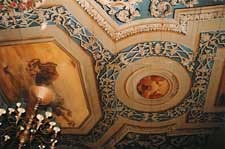
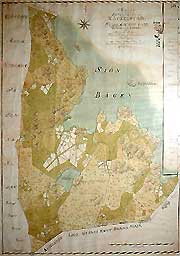
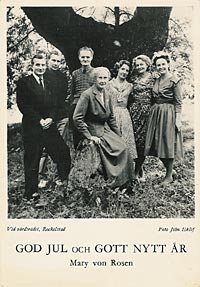
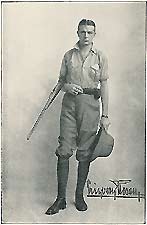
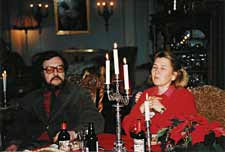
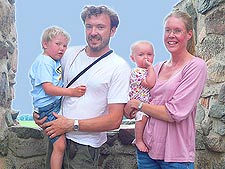
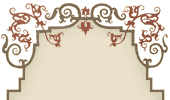








 På Svenska tack
På Svenska tack